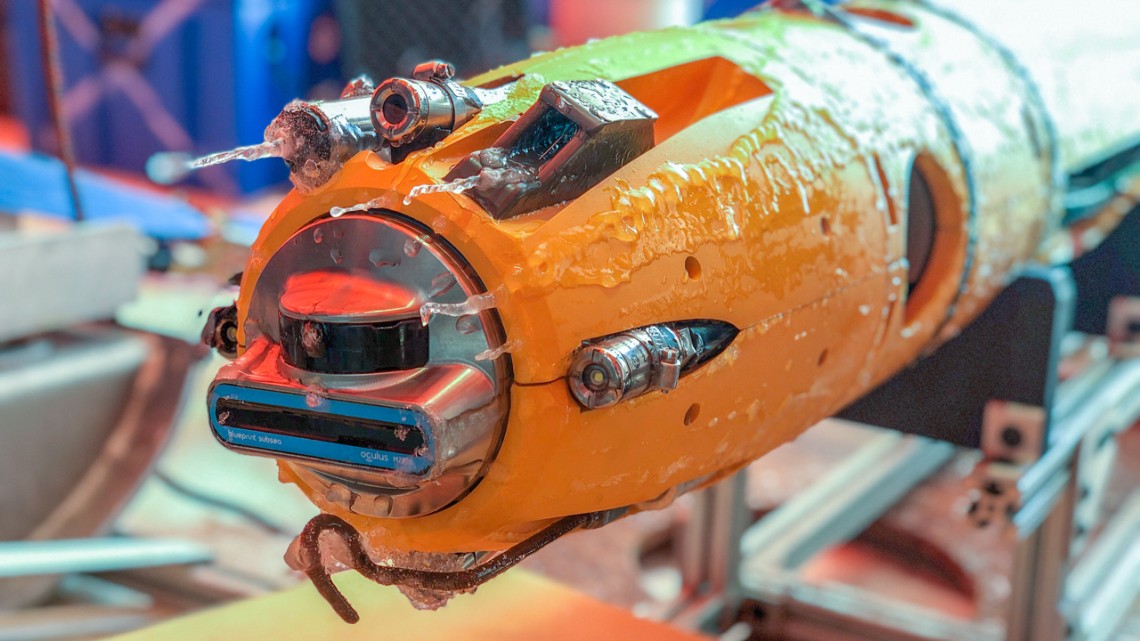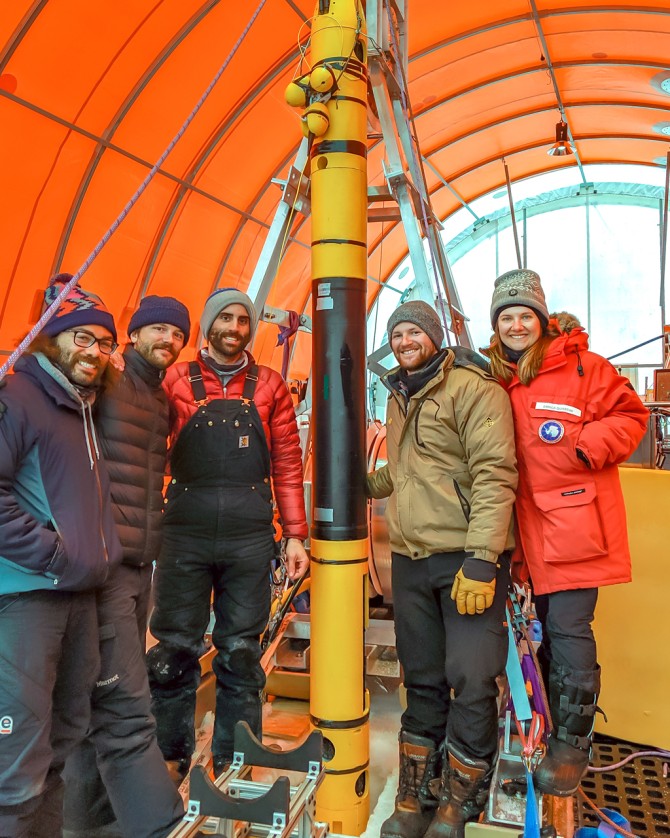
The Icefin underwater vehicle has sonar, chemical and biological sensors that help researchers characterize sub-ice environments.
Underwater robot updates understanding of ice shelf crevasses
By James Dean, Cornell Chronicle
More than merely cracks in the ice, crevasses play an important role in circulating seawater beneath Antarctic ice shelves, potentially influencing their stability, finds Cornell-led research based on first-of-its-kind exploration by an underwater robot.
The remotely operated Icefin robot’s climb up and down a crevasse in the base of the Ross Ice Shelf produced the first 3D measurements of ocean conditions near where it meets the coastline, a critical juncture known as the grounding zone.
The robotic survey revealed a new circulation pattern – a jet funneling water sideways through the crevasse – in addition to rising and sinking currents, and diverse ice formations shaped by shifting flows and temperatures. Those details will improve modeling of ice shelf melting and freezing rates at grounding zones, where few direct observations exist, and of their potential contribution to global sea-level rise.
“Crevasses move water along the coastline of an ice shelf to an extent previously unknown, and in a way models did not predict,” said Peter Washam, a polar oceanographer and research scientist in the Department of Astronomy, in the College of Arts and Sciences (A&S). “The ocean takes advantage of these features, and you can ventilate the ice shelf cavity through them.”
Washam is the lead author of “Direct Observations of Melting, Freezing and Ocean Circulation in an Ice Shelf Basal Crevasse,” published Oct. 27 in Science Advances. Co-authors include members of the Icefin team led by Britney Schmidt, associate professor of astronomy and earth and atmospheric sciences in A&S and Cornell Engineering, and director of the Planetary Habitability and Technology Lab; and members of a New Zealand-based research team led by Christina Hulbe, professor at the University of Otago, and colleagues.
The partners in late 2019 deployed the Icefin vehicle – roughly 12 feet long and less than 10 inches around – on a tether down a 1,900-foot borehole drilled with hot water, near where Antarctica’s largest ice shelf meets the Kamb Ice Stream. Such so-called grounding zones are key to controlling the balance of ice sheets, and the places where changing ocean conditions can have the most impact.
Below the Thwaites Eastern Ice Shelf in West Antarctica, for example, where seawater is comparatively warmer, a separate Icefin expedition detailed melting rates 10 times higher along sloping crevasse walls than along the shelf’s flat base, contributing to the grounding line’s rapid retreat.
The water cavity beneath the Ross shelf is colder and the Kamb Ice Stream has long been stagnant, making it an ideal place to study the long-term effects of underwater conditions more representative of the continent’s largest ice shelves, the researchers said.
On the team’s last of three dives, Matthew Meister, a senior research engineer (A&S), drove Icefin into one of five crevasses found near the borehole. Equipped with thrusters, cameras, sonar and sensors for measuring water temperature, pressure and salinity, the vehicle climbed nearly 150 feet up one slope and descended the other.
The survey detailed changing ice patterns as the crevasse narrowed, with scalloped indentations giving way to vertical runnels, then green-tinted marine ice and stalactites. Melting at the crevasse base and salt rejection from freezing near the top moved water up and down around the horizontal jet, driving uneven melting and freezing on the two sides, with more melting along the lower downstream wall.
“Each feature reveals a different type of circulation or relationship of the ocean temperature to freezing,” Washam said. “Seeing so many different features within a crevasse, so many changes in the circulation, was surprising.”
The researchers said similar currents likely ran through adjacent crevasses. And with Icefin finding similar patterns beneath Thwaites, they said the findings highlight crevasses’ potential to transport changing ocean conditions – warmer or colder – through an ice shelf’s most vulnerable region.
“If water heats up or cools off, it can move around in the back of the ice shelf quite vigorously, and crevasses are one of the means by which that happens,” Washam said. “When it comes to projecting sea-level rise, that’s important to have in the models.”
Additional members of Cornell’s Icefin team in A&S include Justin Lawrence, visiting scholar at the Cornell Center for Astrophysics and Planetary Science; senior research engineer Andrew Mullen; research engineer Frances Bryson ’17; and program manager Enrica Quartini. The team also includes Benjamin Hurwitz, doctoral student at the Georgia Institute of Technology, where Schmidt began developing Icefin as a platform to advance the search for life on icy worlds beyond Earth.
The research was funded by Project RISE UP (Ross Ice Shelf and Europa Underwater Probe), part of NASA’s Planetary Science and Technology from Analog Research program, with logistical support provided by the National Science Foundation through the U.S. Antarctic Program. It was facilitated by the New Zealand Antarctic Research Institute, Aotearoa New Zealand Antarctic Science Platform and the Victoria University of Wellington Hot Water Drilling initiative.
Media Contact
Get Cornell news delivered right to your inbox.
Subscribe

